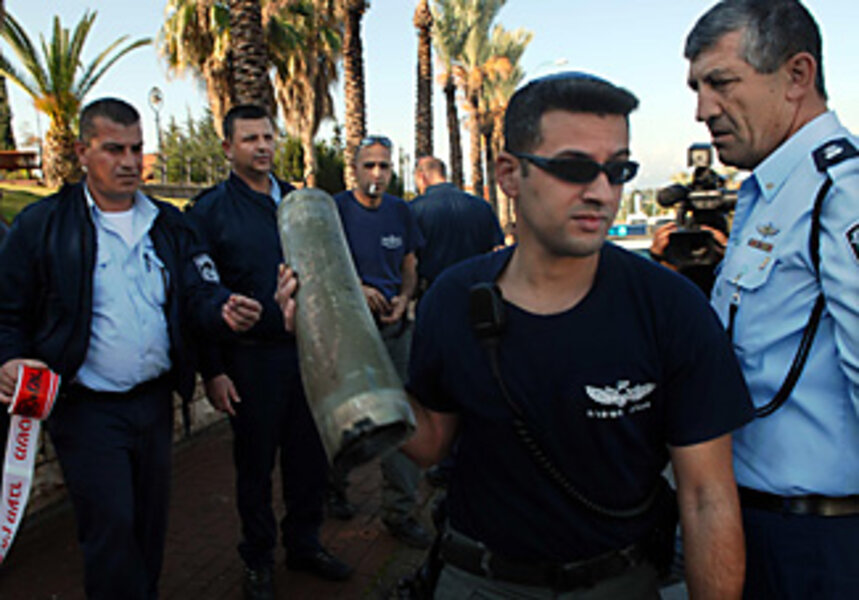Fertilizer, frustration fuel Gaza's rockets
Loading...
| Gaza City, Gaza
After a rocket fired from the Gaza Strip on Jan. 3 landed 17 kilometers (10 miles) inside Israel – deeper than any has penetrated so far – the Israeli press was full of speculation of where the weapon may have come from and how it got into Gaza.
The Israeli army first said the missile was made in Russia. Later it said it had come from Iran. Israeli officials said the weapon was further evidence that the smuggling tunnels between Egypt and Gaza needed to be closed. Israel's Yediot Aharanot newspaper quoted an unnamed Israeli security official alleging the rocket had been smuggled into Gaza by boat.
But lost in the discussion about the origins of the rocket, which fell harmlessly near a hotel on the northern edge of the city of Ashkelon, was a simple fact.
The vast majority of the thousands of rockets that have been fired at Israel from Gaza over the past few years have been made inside the territory. Their range has slowly improved over time as the rocketmakers have experimented with new designs and fuel mixtures. In 2006, a rocket fired from Gaza landed 15 kilometers inside Israel.
Both Israel and President George Bush – who made his first visit to the country last week – have said that Mr. Bush's peace push will fail if the rocket fire from Gaza doesn't stop. But given domestic production of the rockets and makers' ability to fashion them from crude materials, it doesn't appear likely that any blockade can shut them off.
"It's like any other skill … the more you practice, the better you get,'' says one of Gaza's rocketmakers, a heavily bearded 26-year-old as he sits in his workshop in Gaza City. "I'm experimenting with new ideas all the time, and sometimes I get together with other engineers to trade ideas."
This man is a member of one of Gaza's Popular Resistance Committees, and is loosely affiliated with Hamas. He says he's been building rockets for almost five years, and practically glows with pride as he shows off his workshop.
It's a very basic affair at the top floor of one of Gaza's cinder-block apartment buildings. There are sacks of potassium nitrate, or saltpeter, a common fertilizer; sugar; a few machine tools; smaller quantities of gunpowder; and small rocket bodies in various stages of assembly stacked in one corner.
He says he stores the TNT he loads at the head of the rockets elsewhere for safety, and also uses a separate workshop to do his welding.
Aside from the TNT, he uses the basic equipment that generations of model rocket hobbyists in the US have relied on. The metal bodies are fashioned from piping.
The rocketmaker says he makes a couple of small rockets a month with a range of 5 kilometers costing about $300 each. Other workshops affiliated with groups like Islamic Jihad produce far more, he says.
The rockets are a classical weapon of terror, since they can't be aimed with any accuracy and are as likely to fall on a school or a hospital as they are on a military target. Human Rights Watch has condemned the rocket fire for that reason; it has killed few Israelis but has traumatized communities near the border, particularly the town of Sderot, which has been hit dozens of times in recent years.
The rocketmaker says it doesn't bother him that his products might be killing civilians. "Hundreds of us die – children, too – and just a few of them die. I feel like I have no choice – it's either this or surrender."
At the moment, his biggest worry is liquid glucose, which he mixes with the saltpeter to produce the fuel that powers his rockets. An Israeli blockade on most shipping into Gaza has cut the availability of glucose – also used to sweeten cakes, candy, and soda – so he's making his own mixture with granulated sugar.
He also makes a far more extravagant claim: He says the rocket that landed in Ashkelon was his own production, and that he made it at a cost of $900 for the Popular Front for the Liberation of Palestine (PFLP), a communist group that claimed responsibility for that attack. The Palestinian Islamic Jihad also separately claimed the attack as its own.
"I laughed when they said it was from Iran. I've figured out a new fuel mixture. The rocket was three meters long (10 feet) and had 11 kilograms (22 pounds) of TNT in the tip,'' he says. "My techniques are more advanced than everyone else's now."
It was impossible to verify his claim, and it's more than possible that his comments were simply bravado. But it also seems reasonable to believe that the rocketmakers are slowly increasing their products' range as they build bigger rockets that can carry more fuel in their engines.
The first rockets produced in Gaza, usually called Qassams, after the military wing of Hamas, had a range of five kilometers. By 2002, Qassam-2 rockets were being produced that had a range of about nine kilometers. In 2005, Qassam-3s were developed with a range of 10 kilometers.
The Israeli military said the rocket that landed in Ashkelon was a Grad-type Katyusha rocket, originally a Russian design that is in the arsenals of many Eastern European countries and Iran.





